Research on China’s Tourism Public Services Development from the Perspective of Spatial–Temporal Interactions and Based on Resilience Theory
Abstract
1. Introduction
2. Theoretical Analysis
2.1. Connotation of Tourism Public Service
2.2. Sustainable Development of Tourism Public Services under the Concept of Resilience
3. Research Method and Data Sources
3.1. Research Method
3.1.1. Index System Construction
3.1.2. Evaluation Model
3.1.3. Kernel Density Estimation
3.1.4. Spatial Autocorrelation Analysis
3.1.5. Obstacle Degree Model
3.2. Data Sources
4. Results and Analysis
4.1. Temporal Evolution Analysis
4.1.1. Temporal Comprehensive Index Evolution Trend
4.1.2. Temporal Evolution Trend of Subsystem Index
4.2. Analysis of Spatial Evolution Pattern
4.3. Kernel Density Distribution of Each Subsystem
4.4. Tourism Public Services Development Space in Different Provinces
4.5. Diagnosis of Obstacle Factor
4.5.1. Main Obstacle Factor Analysis
4.5.2. Obstacle Degree Analysis of Subsystem
5. Conclusions and Discussion
- Resilience is the sustainable development basis of a regional tourism public service, and maintaining the resilience of the system is also the goal of the sustainable development of tourism public services. According to the theory of adaptive cycles and complex adaptive systems, the tourism public service itself can be regarded as a complex adaptive system composed of multiple elements and covering four subsystems: society, ecology, system and culture. The system itself has problems of internal sustainable development, uneven development within the region, and external uncertain risks such as natural disasters and public health events. Therefore, the structure, function and characteristics of the tourism public services system are constantly adjusted and adapted to the environmental and social changes. Its resilience elements can maintain the secure, stable and orderly development of the system under external disturbances and crisis situations, and it has a good “anti-vulnerability” and “self-adaptability” to form a stable equilibrium state to maintain its own stability. It is an important prerequisite for the sustainable development of tourism public services.
- When assessing the temporal and spatial evolution characteristics of the tourism public services, we found that the development of China’s tourism public services showed a steady upward trend on the whole while it was vulnerable to external disturbances and was unstable; additionally, an insufficient and unbalanced phenomenon from the overall pattern of the development was obtained. From the perspective of time evolution, except for the decline in 2020 due to the COVID-19 epidemic, the overall development momentum of the tourism public services and its subsystems in this study period was good; however, the development trend was not completely consistent. From the perspective of spatial evolution, the optimization trend of China’s tourism public services development was obvious while the development was not balanced. The overall pattern reflected a certain “Matthew effect”, and the balanced development of each subsystem had certain obstacles. It indicated that spatial–temporal evolution is a complex process and is the result of multiple factors. It also showed that China’s tourism public services system had good adaptability and sustainability. However, the tourism public services and their subelements should further strengthen mutual adaptation and coordination, so as to promote the perfection of the tourism public services system and comprehensively improve the development level of the tourism public services. Therefore, it is better to adapt to the current and future problems and impacts that the development of tourism public services may encounter.
- Compared with the development of the tourism industry, the development of the tourism public services is still relatively backward. It is particularly important to focus on adjusting the existing development obstacles and implement policies in different areas to improve the quality and efficiency of the tourism public services and even the sustainable development of tourism. According to the obstacle factor analysis, the obstacle degree value of a single index had no obvious change with the progress of time. It indicated that the existing obstacles affecting the development of tourism public services were not effectively solved in this study period, and the adaptive development ability of the system needs to be further improved. According to the development trend of each subsystem obstacle degree, the development of China’s tourism public services should take the integration of culture and tourism and the reform of the supply side structure as an opportunity, focusing on improving the coverage of tourism infrastructure, optimizing the tourism transportation service, strengthening the construction of the tourism talent team, and improving the level of tourism public information services and public security management. In other words, from the social, ecological, institutional and cultural dimensions that constitute the resilience system of tourism public services, relevant measures and strategies for adaptation and recovery were formulated, and the organization of elements and resource allocation of the tourism public services were paid attention to from a dynamic perspective so as to improve the current supply lag of the tourism public services. It is a key problem for the coordinated and sustainable development of tourism public services and their subsystems.
Author Contributions
Funding
Data Availability Statement
Conflicts of Interest
References
- Seabra, C.; Bhatt, K. Tourism Sustainability and COVID-19 Pandemic: Is There a Positive Side? Sustainability 2022, 14, 8723. [Google Scholar]
- Dang, Q. Research on the Impact of Media Credibility on Risk Perception of COVID-19 and the Sustainable Travel Intention of Chinese Residents Based on an Extended TPB Model in the Post-Pandemic Context. Sustainability 2022, 14, 8729. [Google Scholar] [CrossRef]
- Miguel, O.M.; Mauricio, C.F.; Assumpció, H.; Wilmer, C.F.; Nathalie, L.B.; Orly, C.F. Post-COVID-19 tourists’ preferences, attitudes and travel expectations: A Study in Guayaquil, Ecuador. Int. J. Environ. Res. Public Health 2022, 19, 4822. [Google Scholar]
- Akhtar, N.; Khan, N.; Khan, M.M.; Ashraf, S.; Hashmi, M.S.; Khan, M.M.; Hishan, S.S. Post-COVID 19 tourism: Will Digital Tourism Replace Mass Tourism? Sustainability 2021, 13, 5352. [Google Scholar] [CrossRef]
- Shen, K.; Yang, J. Residents’ Support for Tourism Amidst the COVID-19 Era: An application of social amplification of risk framework and knowledge, attitudes, and practices theory. Int. J. Environ. Res. Public Health 2022, 19, 3736. [Google Scholar] [CrossRef]
- Chica, M.; Hernández, J.M.; Bulchand, G.J. A collective risk dilemma for tourism restrictions under the COVID-19 context. Sci. Rep. 2021, 11, 504. [Google Scholar] [CrossRef]
- Ndou, V.; Mele, G.; Hysa, E.; Manta, O. Exploiting technology to deal with the COVID-19 challenges in travel & tourism: A Bibliometric Analysis. Sustainability 2022, 14, 5917. [Google Scholar]
- Wan, Y.K.P.; Li, X.P.; Lau, V.M.C.; Dioko, L. Destination governance in times of crisis and the role of public-private partnerships in tourism recovery from Covid-19, The case of Macao. J. Hosp. Tour. Manag. 2022, 51, 218–228. [Google Scholar]
- Li, M.L.; Yin, D.X.; Qiu, H.L.; Baic, B. A systematic review of AI technology-based service encounters: Implications for hospitality and tourism operations. Int. J. Hosp. Manag. 2021, 95, 102930. [Google Scholar] [CrossRef]
- Yang, E.J.; Kim, J.W.; Hwang, C.S. The spatial moderating effect of environmental pollution on the relationship between tourism and community resilience. Tour. Manag. 2022, 93, 104554. [Google Scholar] [CrossRef]
- João, R. Tourism, smart specialisation, growth, and resilience. Ann. Tour. Res. 2020, 84, 102995. [Google Scholar]
- Zeng, Y.X.; Zhong, L.S.; Wang, L.E.; Yu, H. Measuring the conflict tendency between tourism development and ecological protection in protected areas: A study on National Nature Reserves in China. Appl. Geog. 2022, 142, 102690. [Google Scholar]
- Kai, K.B.; Matthias, F. Aligning tourism’s socio-economic impact with the United Nations’ sustainable development goals. Tour. Manag. Perspect. 2021, 39, 100831. [Google Scholar]
- Wakil, M.A.; Sun, Y.; Chan, H.W.E. Co-flourishing: Intertwining community resilience and tourism development in destination communities. Tour. Manag. Perspect. 2021, 38, 100803. [Google Scholar] [CrossRef]
- Luthe, T.; Wyss, R. Assessing and planning resilience in tourism. Tour. Manag. 2014, 44, 161–163. [Google Scholar] [CrossRef]
- Cartier, E.; Taylor, L.L. Living in a wildfire: The relationship between crisis management and community resilience in a tourism-based destination. Tour. Manag. Perspect. 2020, 34, 100635. [Google Scholar] [CrossRef]
- Beckens, S.; Mahon, R.; Reneie, H.G. The tourism disaster vulnerability framework: An application to tourism in small island destinations. Nat. Hazards 2014, 71, 955–972. [Google Scholar] [CrossRef]
- Lew, A.A. Scale, change and resilience in community tourism planning. Tour. Geogr. 2014, 16, 14–22. [Google Scholar] [CrossRef]
- Cheung, K.S.; Li, L.H. Understanding visitor-resident relations in over-tourism: Developing resilience for sustainable tourism. J. Sustain. Tour. 2019, 27, 197–1216. [Google Scholar] [CrossRef]
- Huang, S.H.; Shao, Y.H.; Zeng, Y.; Liu, X.Y.; Li, Z.Y. Impacts of COVID-19 on Chinese nationals’ tourism preferences. Tour. Manag. Perspect. 2021, 40, 100895. [Google Scholar] [CrossRef]
- Liu, A.Y.; Kim, Y.R.; Song, H.Y. Toward an accurate assessment of tourism economic impact: A systematic literature review. J. Trauma Acute Care Surg. 2022, 3, 100054. [Google Scholar] [CrossRef]
- Zhang, Z.W.; Plathong, S.; Sun, Y.G.; Guo, Z.; Munnoy, T.; Ma, L.N. Analysis of the island tourism environment based on tourists’ perception—A case study of Koh Lan, Thailand. Ocean Coast. Manag. 2020, 197, 105326. [Google Scholar] [CrossRef]
- Xu, D.; Zhang, J.H.; Huang, Z.F.; Zhou, Y.P.; Fan, Q.Y. Tourism community detection: A space of flows perspective. Tour. Manag. 2022, 93, 104577. [Google Scholar] [CrossRef]
- Natali, L.; Mikel, A.B.; Jose, A.S.F.; Berta, M.L. Assessing social-ecological vulnerability of coastal systems to fishing and tourism. Sci. Total Environ. 2021, 784, 147078. [Google Scholar]
- Anna, S.; Susan, S.; Paul, F.J.E. A decision framework on the choice of management models for park and protected area tourism services. J. Outdoor Rec. Tour. 2019, 26, 72–80. [Google Scholar]
- Ivanochko, O.; Gregus, M.; Szałek, M.; Roliński, J.; Stoliński, B. City tourism services with mobile geolocation sharing. Procedia Comput. Sci. 2021, 191, 49–56. [Google Scholar] [CrossRef]
- Fei, J.H.; Lin, Y.; Jiang, Q.T.; Jiang, K.H.; Li, P.L.; Ye, G.Q. Spatiotemporal coupling coordination measurement on islands’ economy-environment-tourism system. Ocean Coast. Manag. 2021, 212, 105793. [Google Scholar] [CrossRef]
- Ma, S.G.; He, Y.; Gu, R. Joint service, pricing and advertising strategies with tourists’ green tourism experience in a tourism supply chain. J. Retail. Consum. Serv. 2021, 61, 102563. [Google Scholar] [CrossRef]
- Li, S.; Huang, F.C.; Li, J.Z. Tourism public services: Connotation, characteristics and classified framework. Tour. Trib. 2010, 25, 20–26. [Google Scholar]
- Holling, C.S. Resilience and stability of ecological systems. Annu. Rev. Ecol. Syst. 1973, 7, 1–23. [Google Scholar] [CrossRef]
- Farley, J.; Voinov, A. Economics, socio-ecological resilience and ecosystem services. J. Environ. Manage. 2016, 183, 389–398. [Google Scholar] [CrossRef]
- Wang, J.F.; Chen, M.Y.; Feng, L.J.; Yue, J.J. The construction of enterprise tacit knowledge sharing stimulation system oriented to employee individual. Procedia Eng. 2017, 174, 289–300. [Google Scholar]
- Sabatier, R.; Joly, F.; Hubert, B. Assessing both ecological and engineering resilience of a steppe agroecosystem using the viability theory. Agric. Syst. 2017, 157, 146–156. [Google Scholar] [CrossRef]
- Angus, R.; Mclntosh, I.C.B. Ecological and Evolutionary Consequences of Disturbance in Freshwater Ecosystems. Encycl. Inland Waters 2022, 2, 370–381. [Google Scholar]
- Francesca, M.; Ben., L.; Fiona, M.; George, M.C.; David, L. Monitoring tourists’ specialisation and implementing adaptive governance is necessary to avoid failure of the wildlife tourism commons. Tour. Manag. 2020, 81, 104160. [Google Scholar]
- Ali, E.A.; Halit, K.K.; John, C.B. Complex adaptive systems theory and firm product innovativeness. J. Eng. Technol. Manag. 2014, 31, 21–42. [Google Scholar]
- John, E. Cannibals with forks: The triple bottom line of 21st century business. Altern. J. 1999, 25, 42. [Google Scholar]
- Darcy, S.; Cameron, B.; Pegg, S. Accessible tourism and sustainability: A discussion and case study. J. Sustain. Tour. 2010, 18, 515–537. [Google Scholar] [CrossRef]
- Sisto, R.; Cappelletti, G.M.; Bianchi, P.; Sica, E. Sustainable and accessible tourism in natural areas: A participatory approach. Curr. Issues Tour. 2022, 25, 1307–1324. [Google Scholar] [CrossRef]
- Cisneros-Martínez, J.D.; Mccabe, S.; Fernández-Morales, A. The contribution of social tourism to sustainable tourism: A case study of seasonally adjusted programmes in Spain. J. Sustain. Tour. 2018, 26, 85–107. [Google Scholar] [CrossRef]
- Zhang, H.; Tao, L.Y.; Ding, J.; Fang, W.J. Study on coupling coordination between tourism public service quality and tourism economic level in the Yangzeriver economic belt. J. Hefei Univ. Technol. 2021, 35, 1–10. (In Chniese) [Google Scholar]
- Weng, G.M.; Li, C.H.; Pan, Y.; Li, J.P. Analysis on the spatio-temporal evolution and formation mechanism of tourism public service mismatch: Taking nine provinces on the silk road economic belt as cases. Ecol. Econ. 2021, 37, 125–131. (In Chniese) [Google Scholar]
- Gong, Z.G.; Guo, R.; Ma, H.Q.; Li, Z. Tourism economy-tourism public service-population urbanization coupling coordinated development of space-time evolution. Stat. Decis. 2021, 19, 83. (In Chinese) [Google Scholar]
- Xu, Y.F.; Liu, T. Coupling relationship and coordinated development of tourism public service supply and demand. Soc. Sci. 2020, 20, 35–40. [Google Scholar]
- Gisleine, C.Z.; Janaina, F.G.; Evandro, A.B.; Jean, P.O. How sustainable is the nitrogen management in Brazil? A sustainability assessment using the Entropy Weight Method. J. Environ. Manag. 2022, 316, 115330. [Google Scholar]
- Kamill, D.; Kovács, I.H. Tracing out the effect of transportation infrastructure on NO2 concentration levels with Kernel Density Estimation by investigating successive COVID-19-induced lockdowns. Environ. Pollut. 2022, 309, 119719. [Google Scholar]
- Yuan, Y.M.; Cave, M.; Zhang, C.S. Using Local Moran’s I to identify contamination hotspots of rare earth elements in urban soils of London. Appl. Geochem. 2018, 88, 167–178. [Google Scholar] [CrossRef]
- Zhou, J.L.; Wu, Y.N.; Liu, F.T.; Tao, Y.; Gao, J.W. Prospects and obstacles analysis of applying blockchain technology to power trading using a deeply improved model based on the DEMATEL approach. Sustain. Cities Soc. 2021, 70, 102910. [Google Scholar] [CrossRef]

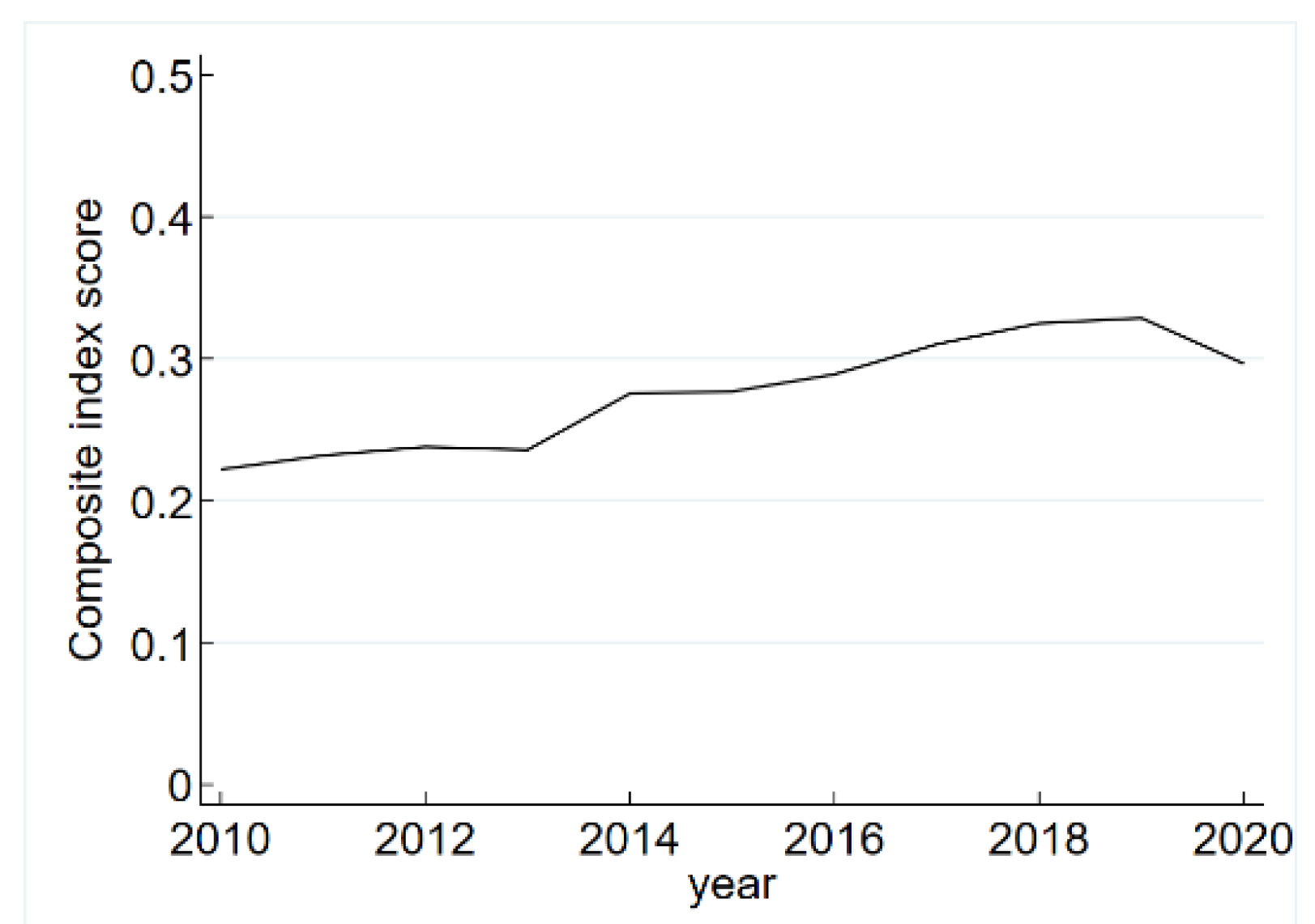
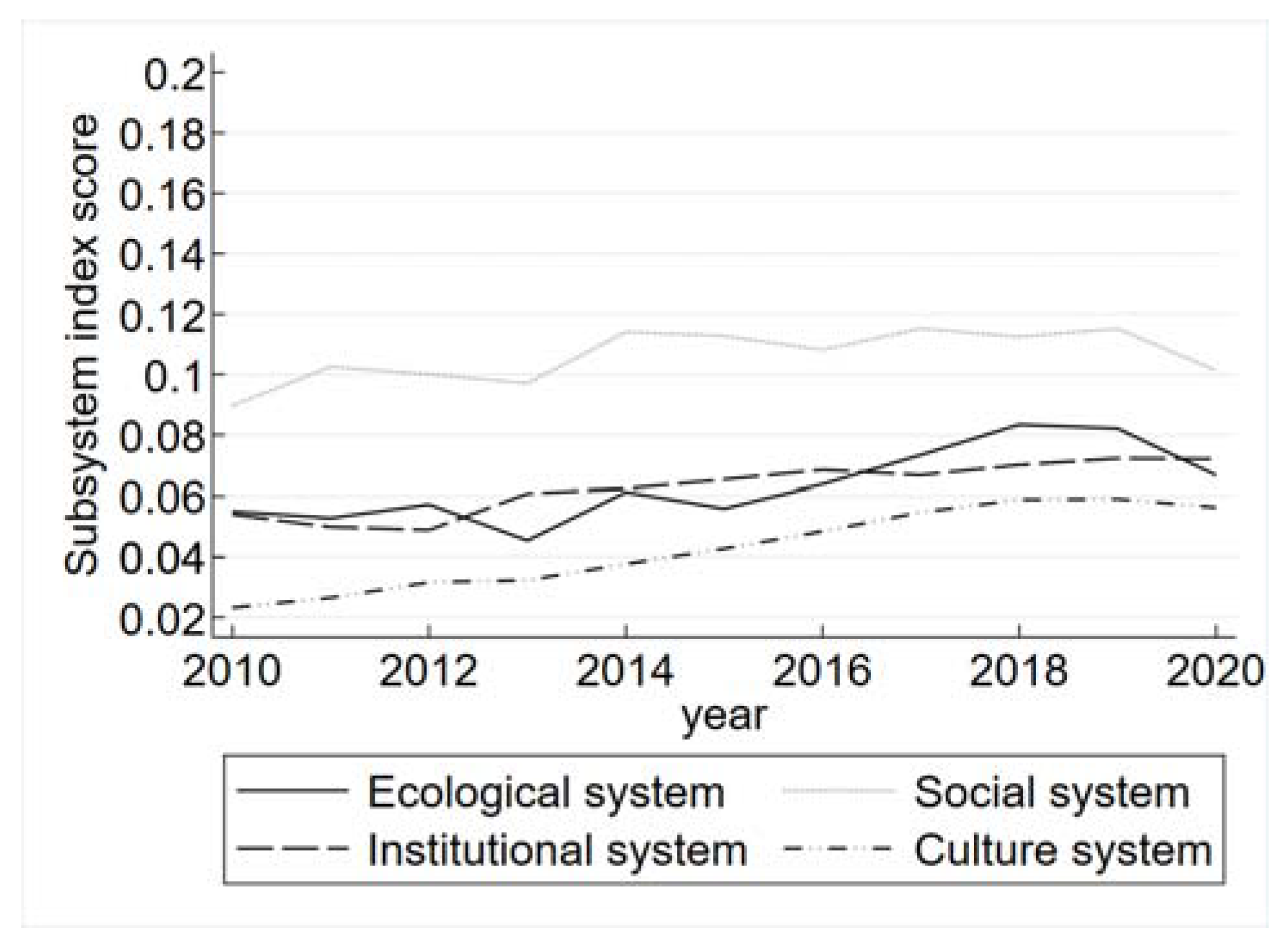
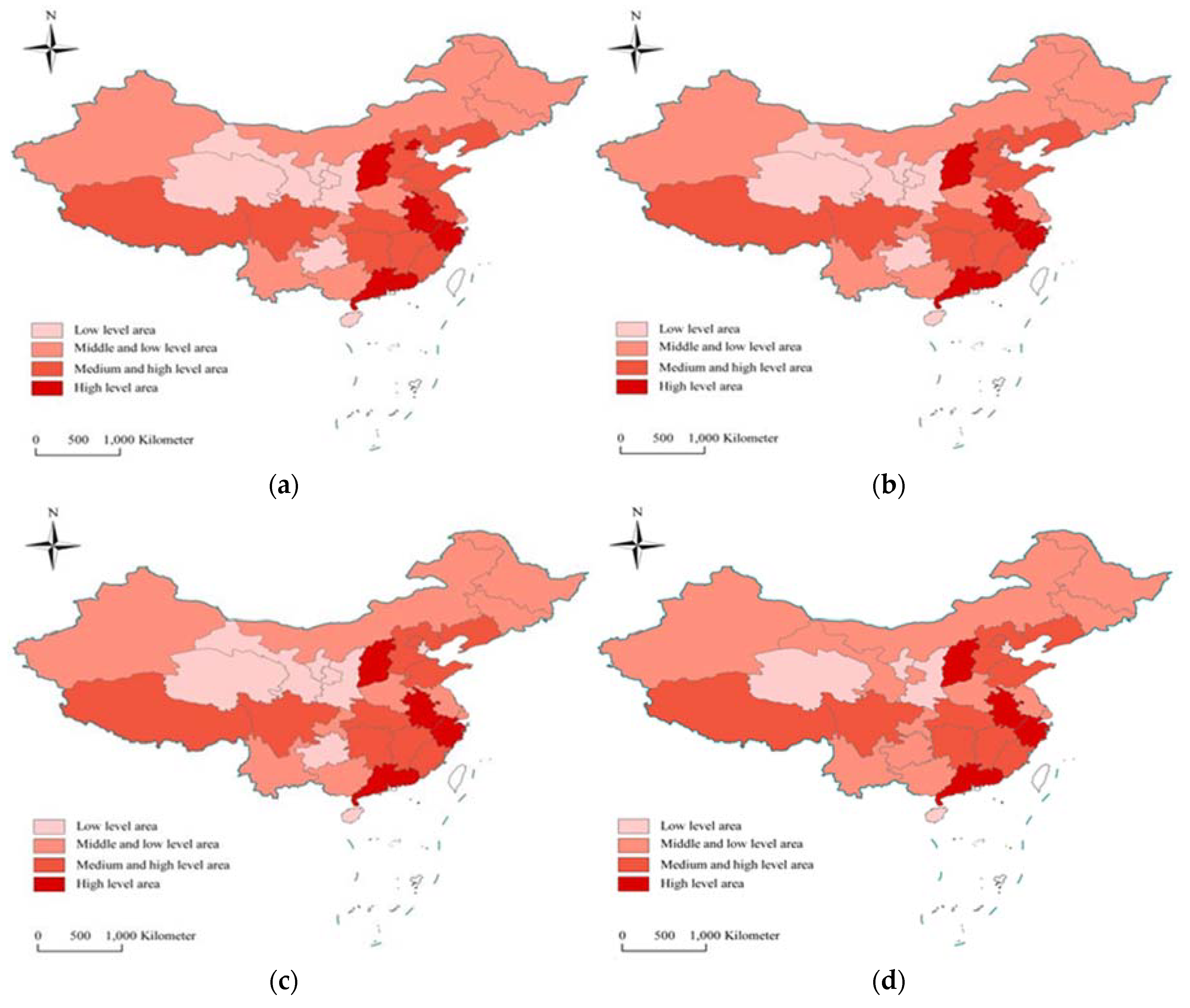
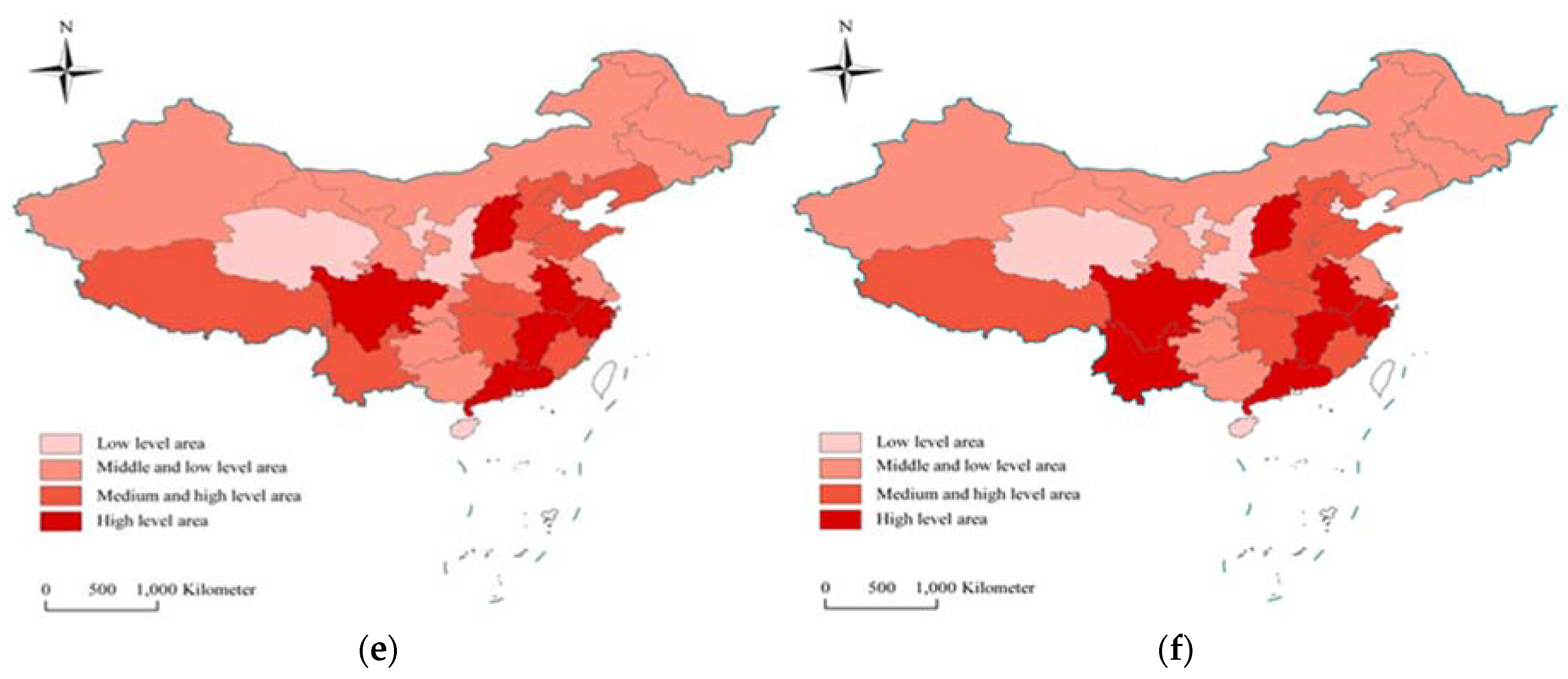
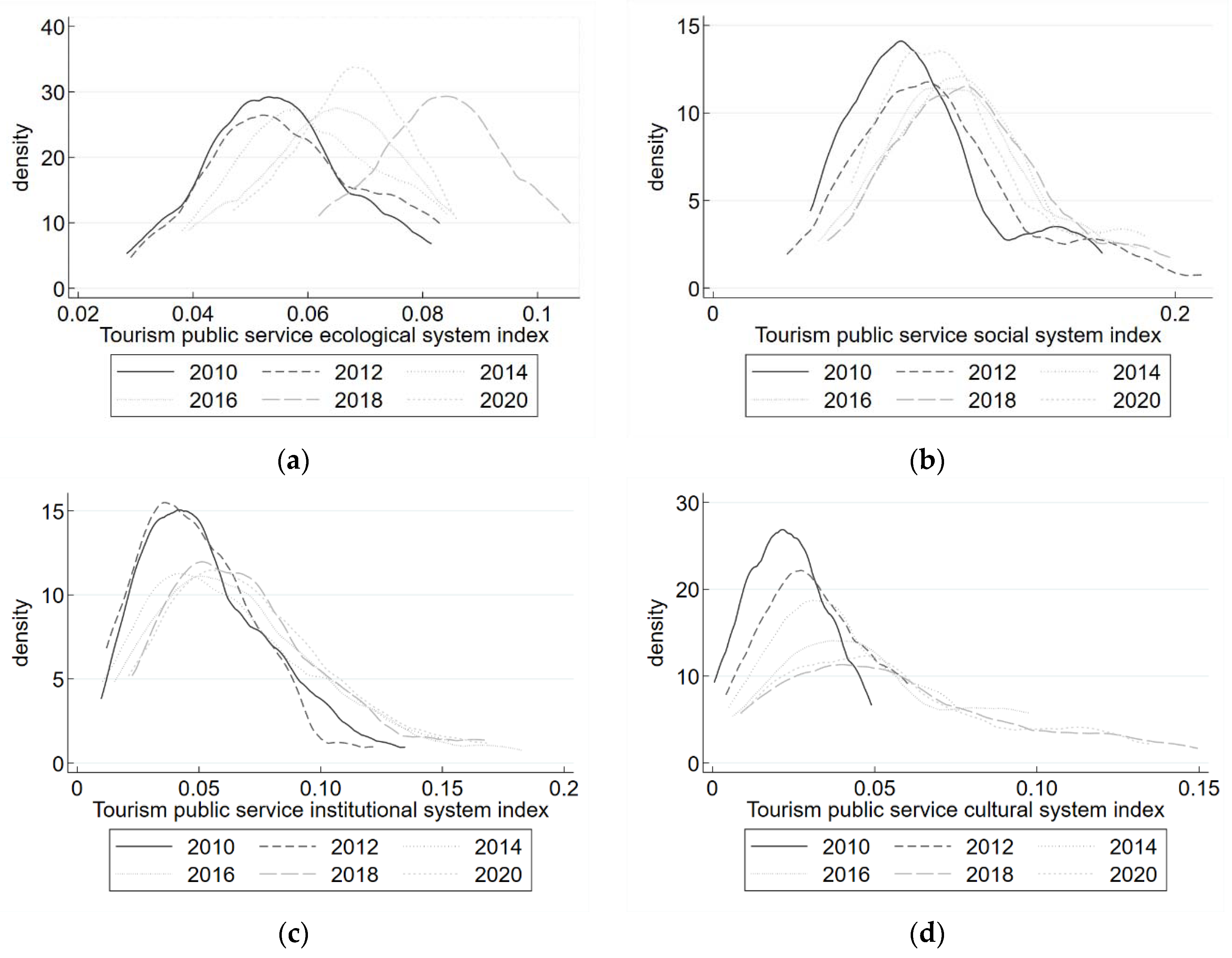
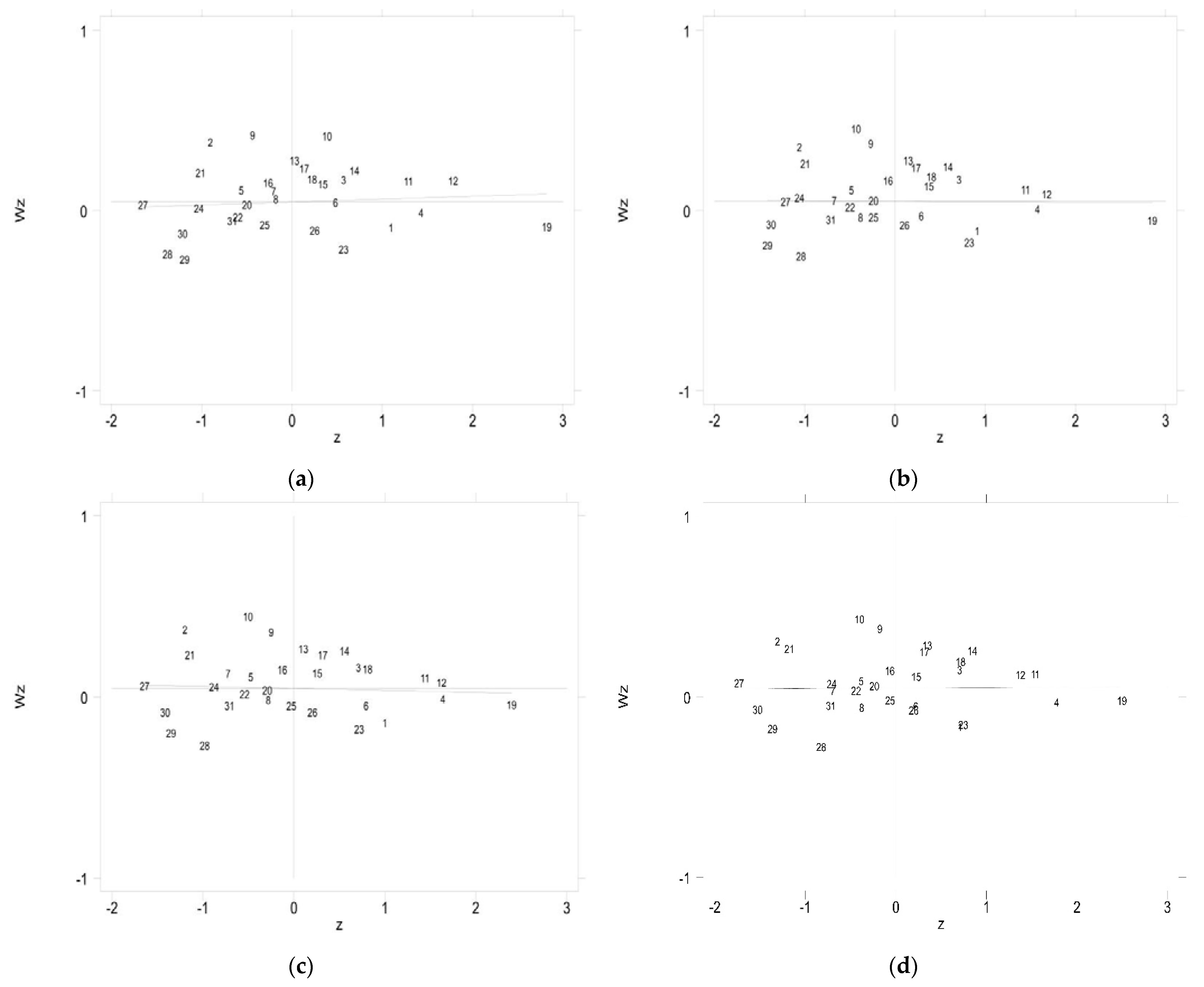
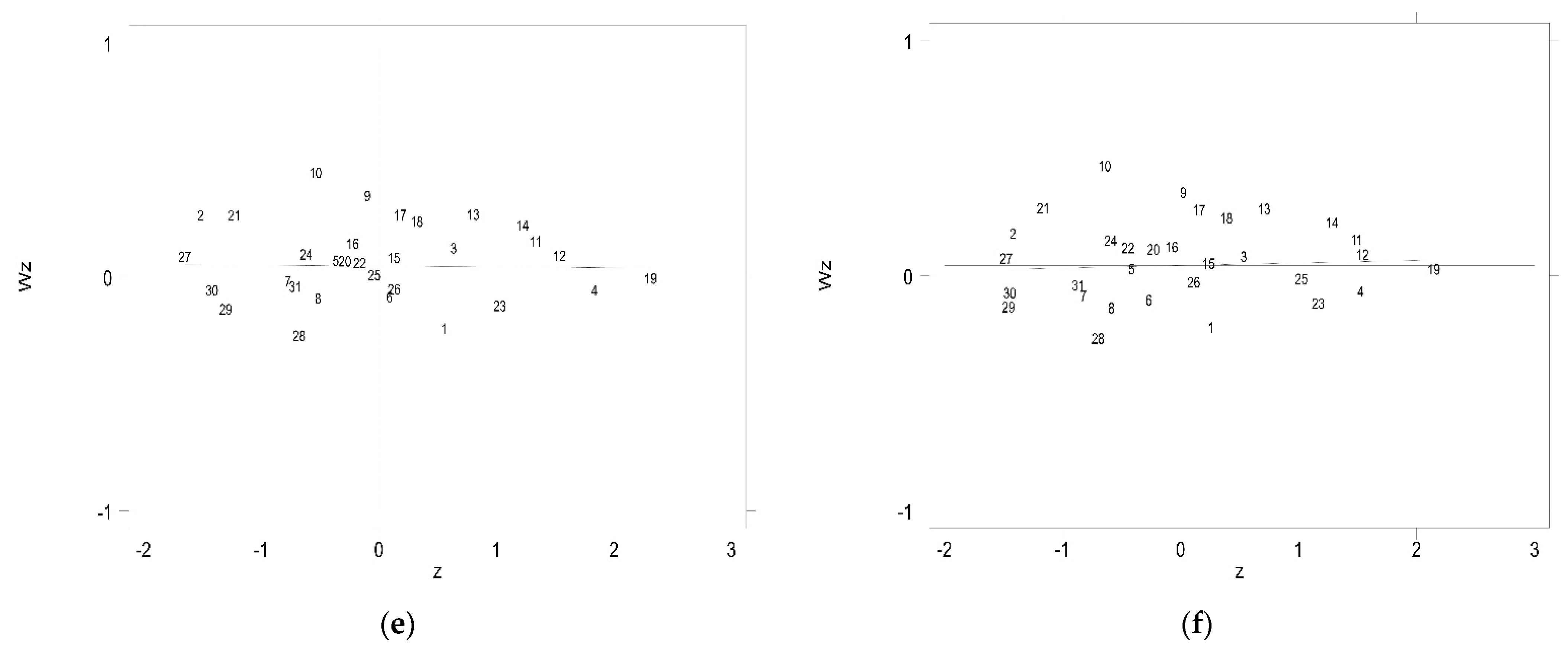
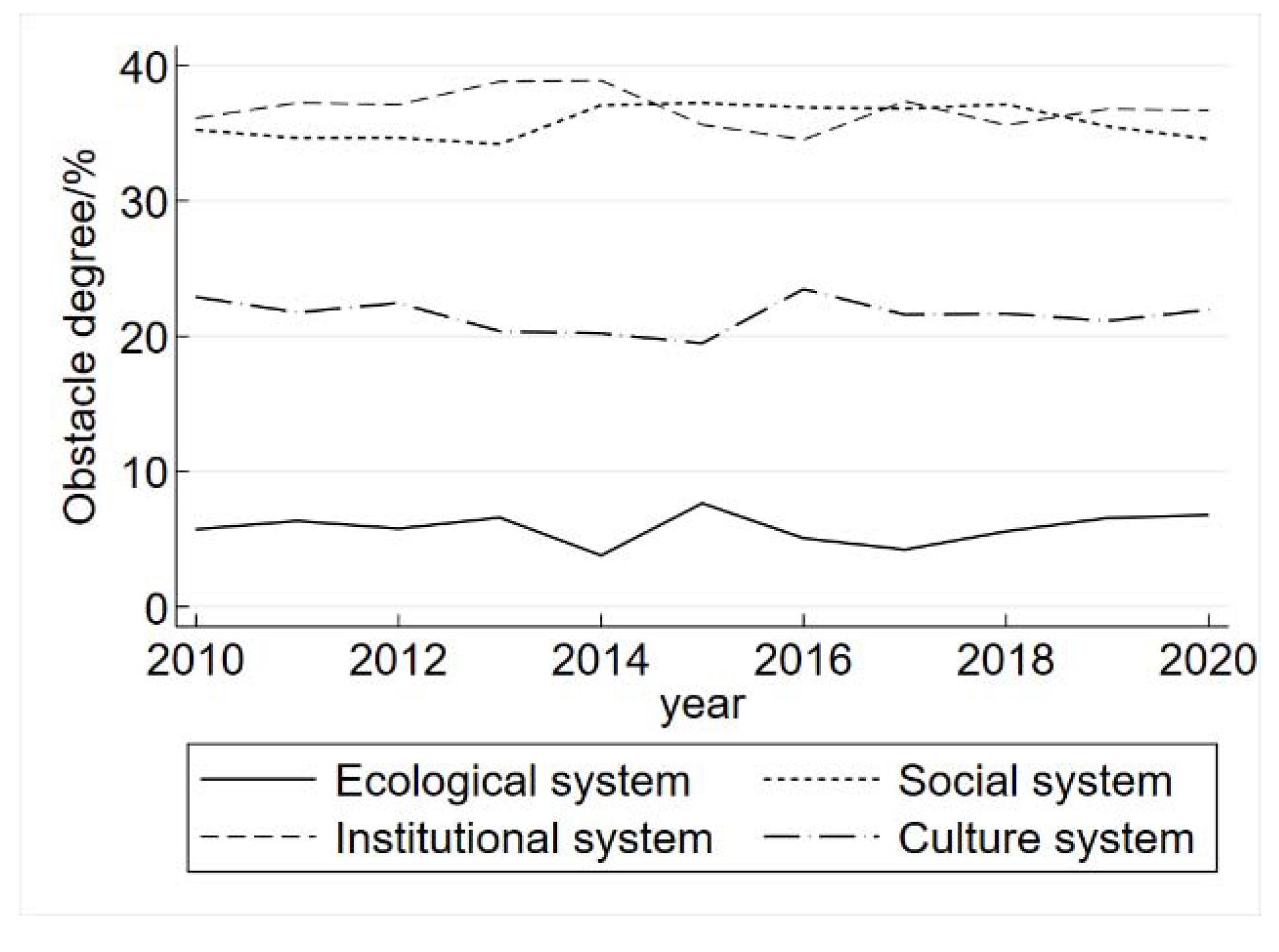
| Target Layer | System Layer | Criterion Layer | Index Layer | Indicator Meaning |
|---|---|---|---|---|
| Development level of tourism public services | Ecological system | Tourist public environment | E1 Forest coverage rate (%) | It represents the forest resources and woodland possession |
| E2 Afforestation coverage rate of built-up area (%) | It represents the greening level of urban public environments | |||
| E3 Per capita park green area (m2/person) | It represents the level of human settlement environments | |||
| E4 Harmless treatment rate of household garbage (%) | It represents the ability and level of environmental governance | |||
| E5 Centralized treatment rate of sewage treatment plants in municipal districts (%) | ||||
| E6 SO2 emissions (ten thousand tons) | It represents the regional environmental pollution status | |||
| Social system | Tourism public information | S1 Mobile phone penetration (%) | It represents the level of regional communication | |
| S2 Broadband internet access port (ten thousand number) | It represents the development level of the Internet | |||
| S3 Comprehensive population coverage of television programs (%) | It represents the coverage status of communication facilities | |||
| S4 Broadcast coverage (%) | ||||
| Tourist transport services | S5 Urban road area per capita (m2) | It represents the level of urban transport infrastructure | ||
| S6 Public transport vehicles for every 10,000 people (number) | It represents the level of public transport | |||
| S7 Railway operating mileage (ten thousand kilometers) | It represents the accessibility of regional tourism transportation | |||
| S8 Railway passenger traffic volume (ten thousand people) | It represents the development level of regional railway traffic | |||
| S9 Highway passenger capacity (ten thousand people) | It represents the development level of regional highway traffic | |||
| Tourism infrastructure | S10 Each unit has a public toilet (seat/ten thousand person) | It represents public infrastructure conditions | ||
| S11 Number of travel agencies (number) | It represents the supporting level of regional tourism public services | |||
| S12 Number of star hotels (number) | ||||
| Institutional system | Travel safety services | I1 Number of health personnel (ten thousand person) | It represents the regional medical rescue capacity | |
| I2 Health technicians per 10,000 people (person) | ||||
| I3 Number of beds in medical institutions per 10,000 people (number) | ||||
| I4 Local finance and public security expenditure (100 million yuan) | It represents the strength of policy support for public security | |||
| I5 Number of health institutions (number) | It represents the level of regional medical service supporting | |||
| Tourism human resources | I6 Employment personnel of travel agency (person) | It represents the labor force in the tourism industry | ||
| I7 Star hotel employment staff (person) | ||||
| I8 Employment in tourist attractions (person) | ||||
| Cultural system | Tourism and entertainment services | C1 Number of performing arts groups (number) | It represents the regional art and cultural environment | |
| C2 Total retail sales of consumer goods (100 million yuan) | It represents the consumption level of residents and its dynamics | |||
| C3 Number of museums (number) | It represents the richness of regional cultural resources | |||
| C4 Public library (number) |
| Name | Sample Size | Mean Value | Standard Deviation | Minimum Value | Maximum Value |
|---|---|---|---|---|---|
| E1 Forest coverage rate | 341 | 33.673 | 18.201 | 4.2 | 66.8 |
| E2 Afforestation coverage rate of built-up area | 341 | 39.237 | 4.090 | 18.1 | 55.10 |
| E3 Per capita park green area | 341 | 12.768 | 2.864 | 5.78 | 21.05 |
| E4 Harmless treatment rate of household garbage | 341 | 91.236 | 12.745 | 38.00 | 100.00 |
| E5 Centralized treatment rate of sewage treatment plants in municipal districts | 341 | 84.695 | 15.148 | 0.06 | 99.6 |
| E6 SO2 emissions | 341 | 45.704 | 39.829 | 0.18 | 182.74 |
| S1 Mobile phone penetration | 341 | 95.980 | 25.881 | 40.87 | 189.46 |
| S2 Broadband internet access port | 341 | 1847.921 | 1673.899 | 17.8 | 8653.2 |
| S3 Comprehensive population coverage of television programs | 341 | 98.536 | 1.462 | 91.4 | 100 |
| S4 Broadcast coverage | 341 | 97.949 | 2.202 | 87.6 | 100 |
| S5 Urban road area per capita | 341 | 15.632 | 4.758 | 4.04 | 26.76 |
| S6 Public transport vehicles for every 10,000 people | 341 | 12.410 | 3.115 | 6.2 | 26.55 |
| S7 Railway operating mileage | 341 | 0.377 | 0.228 | 0.04 | 1.42 |
| S8 Railway passenger traffic volume | 341 | 8083.842 | 5667.789 | 84 | 38,699 |
| S9 Highway passenger capacity | 341 | 62,615.790 | 67,989.968 | 576 | 556,510 |
| S10 Each unit has a public toilet | 341 | 3.033 | 1.126 | 0.77 | 8.15 |
| S11 Number of travel agencies | 341 | 962.035 | 655.585 | 78 | 3390 |
| S12 Number of star hotels | 341 | 345.085 | 189.753 | 55 | 1008 |
| I1 Number of health personnel | 341 | 34.656 | 22.457 | 1.67 | 102.79 |
| I2 Health technicians per 10,000 people | 341 | 61.079 | 17.567 | 25 | 155 |
| I3 Number of beds in medical institutions per 10,000 people | 341 | 50.276 | 13.078 | 15.59 | 79.5 |
| I4 Local finance and public security expenditure | 341 | 265.971 | 206.437 | 4.79 | 1428.11 |
| I5 Number of health institutions | 341 | 31,609.818 | 22,092.285 | 4129 | 86,939 |
| I6 Employment personnel of travel agency | 341 | 11,868.317 | 11,652.309 | 526 | 66,522 |
| I7 Star hotel employment staff | 341 | 42,274.273 | 37,159.124 | 364 | 372,838 |
| I8 Employment in tourist attractions | 341 | 28,554.196 | 32,562.665 | 141 | 202,284 |
| C1 Number of performing arts groups | 341 | 379.282 | 448.751 | 16 | 2859 |
| C2 Total retail sales of consumer goods | 341 | 9408.605 | 8214.641 | 192.4 | 42,951.80 |
| C3 Number of museums | 341 | 127.328 | 94.529 | 2 | 577 |
| C4 Public library | 341 | 100.211 | 46.241 | 4 | 207 |
| Period | Ecological System | Social System | Institutional System | Cultural System | Index |
|---|---|---|---|---|---|
| 2010 | 0.055 | 0.090 | 0.054 | 0.023 | 0.222 |
| 2011 | 0.053 | 0.103 | 0.050 | 0.026 | 0.232 |
| 2012 | 0.057 | 0.100 | 0.049 | 0.032 | 0.238 |
| 2013 | 0.045 | 0.097 | 0.061 | 0.032 | 0.236 |
| 2014 | 0.061 | 0.114 | 0.062 | 0.038 | 0.275 |
| 2015 | 0.056 | 0.113 | 0.065 | 0.043 | 0.277 |
| 2016 | 0.064 | 0.108 | 0.069 | 0.048 | 0.289 |
| 2017 | 0.073 | 0.115 | 0.067 | 0.055 | 0.310 |
| 2018 | 0.083 | 0.112 | 0.070 | 0.059 | 0.325 |
| 2019 | 0.082 | 0.115 | 0.072 | 0.059 | 0.329 |
| 2020 | 0.067 | 0.101 | 0.072 | 0.056 | 0.296 |
| No. | 2010 | 2012 | 2014 | 2016 | 2018 | 2020 | ||||||
|---|---|---|---|---|---|---|---|---|---|---|---|---|
| OFs | OB/% | OFs | OB/% | OFs | OB/% | OFs | OB/% | OFs | OB/% | OFs | OB% | |
| 1 | C1 | 10.04 | C1 | 10.31 | I8 | 9.54 | C1 | 12.15 | C1 | 10.08 | C1 | 9.47 |
| 2 | I8 | 9.56 | I8 | 9.15 | S9 | 9.02 | I8 | 9.58 | S9 | 8.70 | I8 | 8.88 |
| 3 | S9 | 8.92 | S9 | 8.71 | C1 | 8.43 | S9 | 8.85 | I8 | 8.33 | S9 | 8.18 |
| 4 | I6 | 6.35 | I6 | 7.04 | I6 | 7.38 | I7 | 6.03 | I6 | 7.40 | I6 | 7.02 |
| 5 | S2 | 6.25 | C2 | 6.16 | S2 | 6.12 | S2 | 5.61 | C2 | 6.13 | C2 | 6.29 |
| 6 | C2 | 5.99 | S2 | 5.97 | C2 | 5.91 | I6 | 5.32 | S2 | 5.97 | S2 | 6.19 |
| 7 | I7 | 5.35 | I7 | 5.56 | I7 | 5.81 | C3 | 5.06 | I7 | 5.41 | I5 | 5.68 |
| 8 | C3 | 4.98 | I5 | 5.38 | I5 | 4.93 | C2 | 5.01 | C3 | 4.43 | I7 | 5.18 |
Disclaimer/Publisher’s Note: The statements, opinions and data contained in all publications are solely those of the individual author(s) and contributor(s) and not of MDPI and/or the editor(s). MDPI and/or the editor(s) disclaim responsibility for any injury to people or property resulting from any ideas, methods, instructions or products referred to in the content. |
© 2022 by the authors. Licensee MDPI, Basel, Switzerland. This article is an open access article distributed under the terms and conditions of the Creative Commons Attribution (CC BY) license (https://creativecommons.org/licenses/by/4.0/).
Share and Cite
Yang, S.; Guo, W. Research on China’s Tourism Public Services Development from the Perspective of Spatial–Temporal Interactions and Based on Resilience Theory. Sustainability 2023, 15, 4. https://doi.org/10.3390/su15010004
Yang S, Guo W. Research on China’s Tourism Public Services Development from the Perspective of Spatial–Temporal Interactions and Based on Resilience Theory. Sustainability. 2023; 15(1):4. https://doi.org/10.3390/su15010004
Chicago/Turabian StyleYang, Shuo, and Wei Guo. 2023. "Research on China’s Tourism Public Services Development from the Perspective of Spatial–Temporal Interactions and Based on Resilience Theory" Sustainability 15, no. 1: 4. https://doi.org/10.3390/su15010004
APA StyleYang, S., & Guo, W. (2023). Research on China’s Tourism Public Services Development from the Perspective of Spatial–Temporal Interactions and Based on Resilience Theory. Sustainability, 15(1), 4. https://doi.org/10.3390/su15010004






